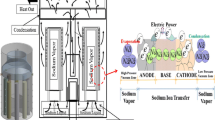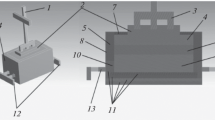Abstract
In the present study, a numerical simulation and experimental studies of an alkali-metal thermoelectric energy converter (AMTEC) system were carried out. The present, unique AMTEC model consists of an evaporator, a β-alumina solid electrolyte (BASE) tube, a condenser, and an artery cable wick. The key points for operation of the present AMTEC were 1100 K in the evaporator and 600 K in the condenser. A numerical model based on sodium-saturated porous wicks was developed and shown to be able to simulate the AMTEC system. The simulation results show that the AMTEC system can generate up to 100 W with a given design. The AMTEC system developed in the present work and used in the practical investigations could generate an electromotive force of 7 V. Artery wick and evaporator wick structures were simulated for the optimum design. Both sodium-saturated wicks were affected by numerous variables, such as the input heat power, cooling temperature, sodium mass flow rate, and capillary-driven fluid flow. Based on an effective thermal conductivity model, the presented simulation could successfully predict the system performance. Based on the numerical simulation, the AMTEC system operates with efficiency near 10% to 15%. In the case of an improved BASE design, the system could reach efficiency of over 30%. The system was designed for 0.6 V power, 25 A current, and 100 W power input. In addition, in this study, the temperature effects in each part of the AMTEC system were analyzed using a heat transfer model in porous media to apply to the computational fluid dynamics at a predetermined temperature condition for the design of a 100-W AMTEC prototype. It was found that a current density of 0.5 A/cm2 to 0.9 A/cm2 for the BASE is suitable when the temperatures of the evaporator section and condenser section are 1100 K and 600 K, respectively.
Similar content being viewed by others
Abbreviations
- A :
-
Area (m2)
- C p :
-
Heat capacity (kJ/kg-K)
- F :
-
Faraday constant (Coulomb/g-mole)
- F ij :
-
View factor
- G :
-
Dimensionless pore geometry factor, 40
- h :
-
Specific static enthalpy (kJ/kg)
- h fg :
-
Sodium latent heat (J/kg)
- h tot :
-
Specific total enthalpy (kJ/kg)
- I b :
-
Blackbody emission intensity (%)
- I vo :
-
Radiation intensity leaving the boundary (%)
- I v :
-
Mean radiation intensity (%)
- I :
-
Electric current (A)
- J :
-
Current density (A/cm2)
- K a :
-
Absorption coefficient (m−1)
- K av :
-
Absorption coefficient for wavelength (m−1)
- K s :
-
Scattering coefficient (m−1)
- K sv :
-
Scattering coefficient for wavelength (m−1)
- M Na :
-
Sodium molecular weight (g/mole)
- p :
-
Static pressure (N/m2)
- P d :
-
Pressure drop of BASE (N/m2)
- Poout :
-
Power output (W)
- P 2 − P 1 :
-
Capillary pressure drop of liquid between evaporator and condenser (N/m2)
- P v :
-
Saturation pressure (N/m2)
- ΔP f :
-
Pressure loss of liquid flow in wick (N/m2)
- ΔP g :
-
Pressure head (N/m2)
- Q c :
-
Heat loss in condenser (W)
- Q Rad :
-
Radiative heat loss (W)
- \( q_{\rm{v}}^{\rm{R}} \) :
-
Proportional to the rate of incidence of photons of the surface at r (W/m2)
- r :
-
Distance (m)
- R BASE :
-
BASE resistance (Ω)
- R :
-
Universal gas constant (J/gmole-K)
- R Cable :
-
Cable resistance (Ω)
- R Contact :
-
Contact resistance (Ω)
- R Electrode :
-
Electrode resistance (Ω)
- R total :
-
Resistances in the cell (Ω)
- r :
-
Position vector
- S :
-
Radiation intensity source (W/m3)
- S E :
-
Energy source (W/m3)
- S M :
-
Momentum source (kg/m2 s2)
- s :
-
Direction vector
- T :
-
Temperature (K)
- T BASE :
-
Temperature of BASE (K)
- T cond :
-
Temperature of condenser (K)
- t :
-
Time (s)
- U :
-
Vector of velocity (m/s)
- V B :
-
Voltage across the cell (V)
- v :
-
Frequency (Hz)
- α :
-
The property ratio (α = λ 2/λ 1)
- δ :
-
Identity matrix
- η :
-
AMTEC cell efficiency
- λ :
-
Thermal conductivity (W/m-K)
- λ e :
-
The corresponding effective property (W/m-K)
- λ 1 :
-
The property of the continuous phase (W/m-K)
- λ 2 :
-
The property of the dispersed phase (W/m-K)
- μ :
-
Dynamic viscosity (Ns/m2)
- ρ :
-
Fluid density (kg/m3)
- τ :
-
Shear stress (N/m2)
- ϕ :
-
Volume fraction of the dispersed phase
- Ω′:
-
Solid angle (steradians)
References
T. Cole, Science 221, 915 (1983).
T. Kotaro, Heat Transf. Asian Res. 30, 234 (2001).
M.A.K. Lodhi, and V.R. Malka, Power Source, (2005).
H. Oman, IEEE Aerosp. Electron. Syst. Mag. 16, 37 (2001).
S.Y. Wu, B.X. Cas, L. Xiao, and Y.R. Li, J. Mech. Sci. Technol. 26, 973–981 (2012).
M.A. Ryan, R.M. Williams, C.E. Allevato, C.B. Vining, C.K. Lowe-Ma, and S.B. Robie, J. Phys. Chem. Solids 55, 1255–1260 (1994).
S.E. Mohamed and J.P. Tournier, Energy Convers. Manag. 45, 511–535 (2004).
K.B. Lee, S.H. Rhi, K.W. Lee, W.H. Lee, C.C. Jang, W.G. Lee, N.K. Kim, and D.R. Shin, Adv. Mater. Res. 538–541, 419 (2012).
Thermacore Inc, Research Final Report of Year 1997, Contract# DE-FG05-91 ER81233, Thermacore, (1997).
C. Zhou, X. Wei, and Z. Song, Proceedings of 11th International Energy Conversion Engineering Conference, (2013).
ANSYS CFX-Solver Theory Guide, Release 14.5, (2012).
M. Kaviany, Principles of Heat Transfer in Porous Media (New York: Springer, 1991).
S. Ayatollahi, N. Saber, M.J. Amani, and A. Bitaab, J. Porous Media 9, 1 (2006).
J. Petrasch, B. Schrader, P.R. Wyss, and A. Steinfeld, J. Heat Transfer 130, (2008).
M. Wang and N. Pan, Mater. Sci. Eng. R 63, 1–30 (2008).
J.A. del Rio, R.W. Zimmerman, and R.A. Dawe, Solid State Commun. 106, 183–186 (1998).
J.K. Fink and L. Leibowitz, Argonne National Laboratory for the United States Department of Energy under Contract W-31-109-Eng-38.
W.G. Anderson and J.J. Bland, Technical Report. Thermacore INC., U. S. Department of Energy, (1997).
N. Qiuya, G. Lou, J. Zhang, M. Chu, Y. Kan, and Y.J. Tong, Energy Conversion Engineering Conference and Exhibit IECEC, 3, p. 1295 (2000).
Author information
Authors and Affiliations
Corresponding author
Rights and permissions
About this article
Cite this article
Lee, WH., Hwang, HC., Lee, JS. et al. Study on the Characteristics of an Alkali-Metal Thermoelectric Power Generation System. J. Electron. Mater. 44, 3534–3544 (2015). https://doi.org/10.1007/s11664-015-3818-1
Received:
Accepted:
Published:
Issue Date:
DOI: https://doi.org/10.1007/s11664-015-3818-1




